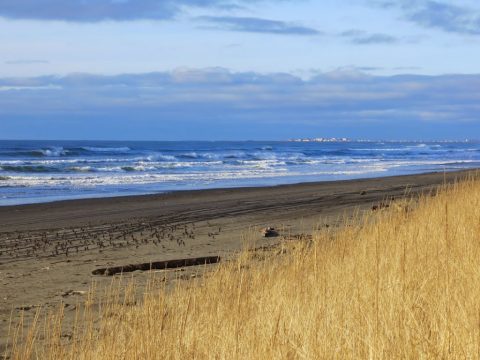
For the past couple of years, researchers with the Pacific Northwest Climate Impacts Research Consortium (CIRC) and the Oregon State University have been using advanced computer modeling to estimate what the shorelines of Grays Harbor County may look like in the future. This project, aptly named “Grays Harbor County Coastal Futures,” used stakeholder input and a large data set to produce maps and other information that project the fate of the coastline.
 The Grays Harbor Coastal Futures team from Oregon State University sharing their results with the Grays Harbor community.
The Grays Harbor Coastal Futures team from Oregon State University sharing their results with the Grays Harbor community.
It is no secret that the Washington coastline is a rugged and dynamic system that is frequently exposed to powerful storms, mostly in the winter months, that can cause significant flooding and erosion. While it is difficult to predict the exact increase of sea level in future years, there is no doubt that it will rise. And when Sea Level Rise (SLR) is coupled with major storm events the results will be more flooding and erosion that will threaten public infrastructure, private property, natural resources and beach access. Difficult policy decisions will need to be made in the coming years to minimize these impacts and this project provides a starting point.
The Scenarios
The Grays Harbor Coastal Futures team utilized a wealth of data sets that included topography, habitat maps, infrastructure, property lines, the latest SLR projections and much more. They fed all this information into a powerful modeling program in order to produce maps projecting what the shorelines of Grays Harbor may look like in 2100. As you might imagine, there are a fair amount of assumptions that need to be made in order to do this, and the team did their very best to clearly articulate their assumptions. In order to narrow the possible modeling variables they used four different scenarios; this also helped demonstrate the pros and cons of prioritizing certain policies. Here are the four scenarios:
The Results
The unfortunate reality is that there is no perfect solution to the challenges that the Washington coast will face in the not too distant future. We could choose to do nothing proactively and respond to problems as they arise but this would be most unwise and extremely expensive in the long run. We could create programs that allow private property owners to move their homes out of harm's way but that will also be very expensive and the shoreline will move significantly inland. We could choose to protect all infrastructure and private homes by hard armoring the coast but the beach will become steeper, razor clams will disappear, and beach access and recreational opportunities will be lost, thus harming local economies. We could choose to enhance and restore natural habitats that will protect wildlife and buffer the impacts of SLR but we will still need to move homes out of harm's way. All scenarios show that sacrifices will need to be made, whether it's taxpayer dollars, razor clam beds, private property, infrastructure, or beach access.
Implications
The final results of the CIRC project will be available in the coming months and we will make sure to share them on this blog. The take home message is that there are extremely hard decisions ahead for coastal communities. In reality, the most likely approach will be a combination of the scenarios outlined above. The sooner that we can begin the difficult conversations about how to plan for the future the better. There are a growing number of individuals and organizations, including Surfrider, who want to be proactive and the results of this project will help considerably.
It is encouraging that several ongoing activities are looking at these significant challenges. The Ruckelshaus Center produced the Washington State Coastal Resiliency Assessment last year and Governor Inslee recently tasked the Washington Coast Marine Advisory Council (WCMAC) to focus on coastal resiliency. The WCMAC is currently assessing the Ruckelshaus report and is considering how to address the recommendations. With all this focus and momentum there is a real opportunity to proactively plan for the threats that are on the horizon. In fact, it is a necessity if we want to ensure strong coastal communities and healthy beaches for our children.



